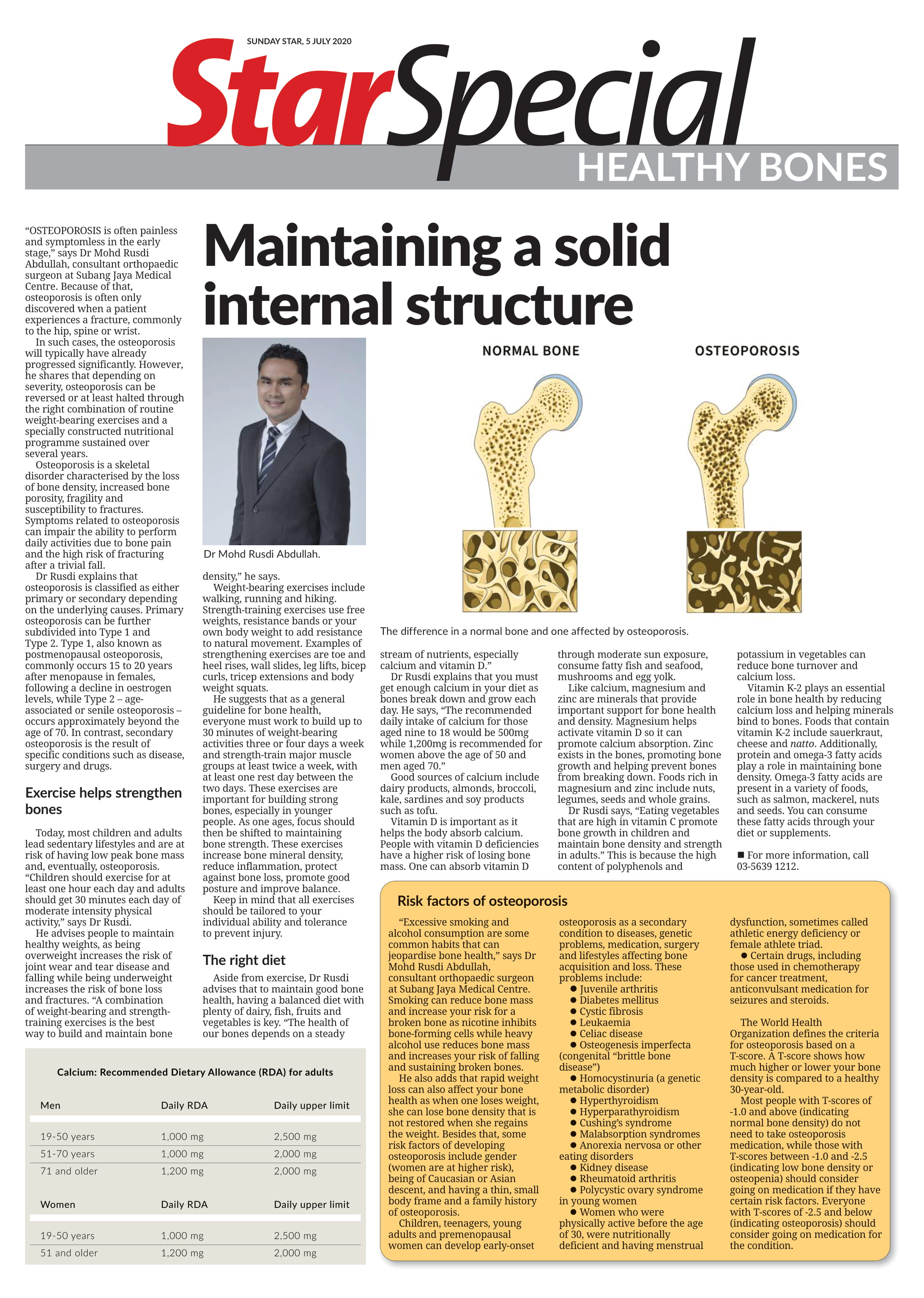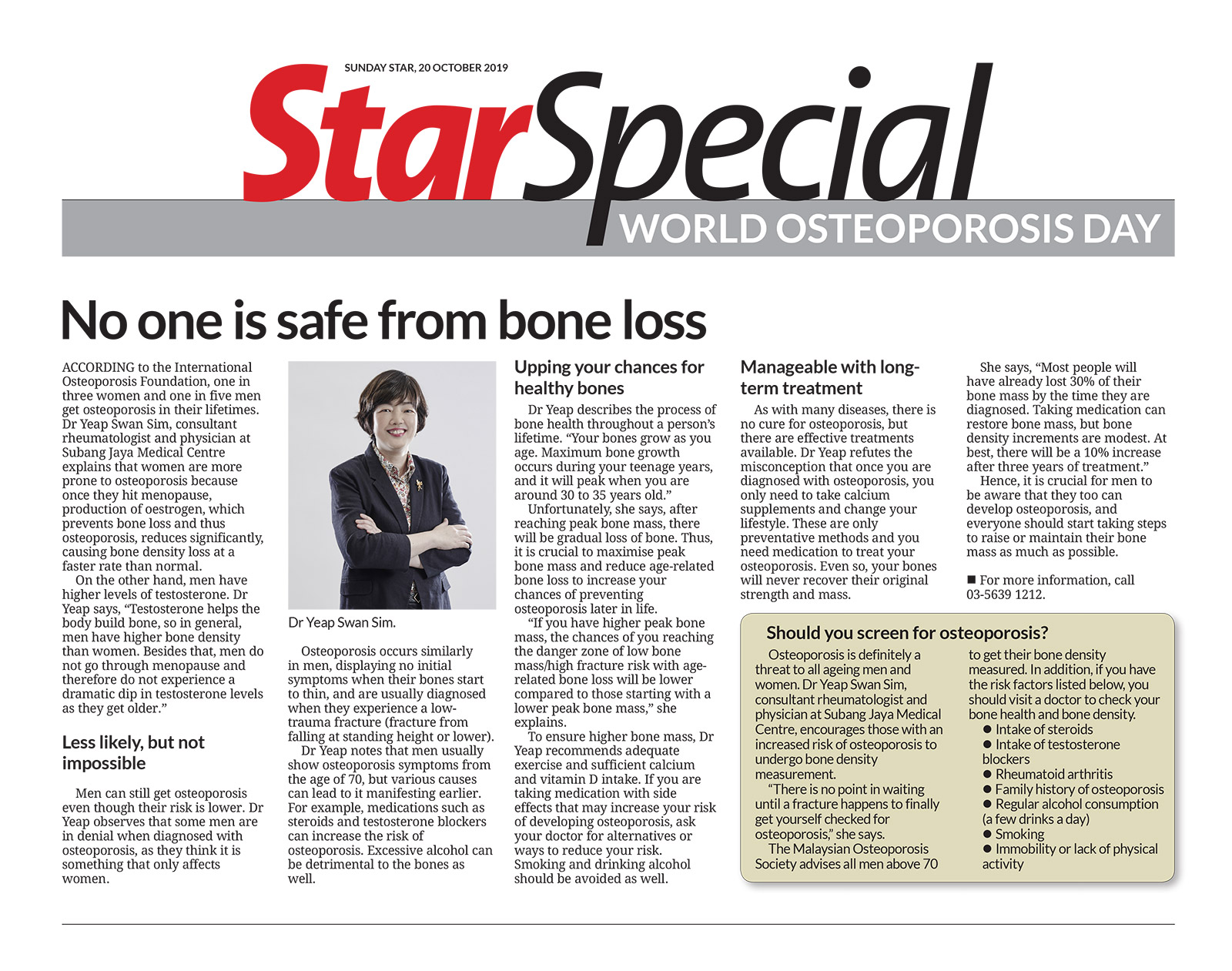What is Osteoporosis?
Osteoporosis is a skeletal disorder characterised by the loss of bone density, increased bone porosity, fragility and susceptibility to fractures. Symptoms related to osteoporosis can impair the ability to perform daily activities due to bone pain and the high risk of fracturing after a trivial fall.
Classification of Osteoporosis:
1. Primary osteoporosis
Type 1 - Postmenopausal osteoporosis, commonly occurs 15 to 20 years after menopause in females, following a decline in oestrogen levels.
Type 2 - Age-associated or senile osteoporosis that occurs approximately beyond the age of 70.
2. Secondary osteoporosis
A result of specific conditions such as disease, surgery and drugs.
Who is at risk of osteoporosis?
According to the International Osteoporosis Foundation, one in three women and one in five men get osteoporosis in their lifetimes. Dr Yeap Swan Sim, consultant rheumatologist and physician at Subang Jaya Medical Centre, explains “Men have higher levels of testosterone. Testosterone helps the body build bone, so in general, men have higher bone density than women. Besides that, men do not go through menopause and therefore do not experience a dramatic dip in testosterone levels as they get older.”
Risk factors for osteoporosis:
Smoking – Reduces bone mass and increases the risk for broken bones as nicotine inhibits bone-forming cells.
Alcohol – Heavy alcohol use reduces bone mass and increases the risk of falling and sustaining broken bones.
Rapid weight loss – When one loses weight, bone density can be lost and not restored when the weight is regained.
Gender – Women are more prone to osteoporosis because once they hit menopause, production of oestrogen, which prevents bone loss reduces significantly, causing bone density loss at a faster rate than normal.
Exercise helps strengthen bones
Today, most children and adults lead sedentary lifestyles and are at risk of having low peak bone mass and, eventually, osteoporosis. "Children should exercise for at least one hour each day and adults should get 30 minutes each day of moderate intensity physical activity," says Dr Rusdi.
He advises people to maintain healthy weights, as being overweight increases the risk of joint wear and tear disease and falling while being underweight increases the risk of bone loss and fractures. "A combination of weight-bearing and strength-training exercises is the best way to build and maintain bone density," he says.
Types of Exercises:
Weight-bearing exercises - Walking, running and hiking
Strength-training exercises - Use free weights, resistance bands or your own body weight to add resistance to natural movements. For example, toe and heel rises, wall slides, leg lifts, bicep curls, tricep extensions and body weight squats.
Recommended frequency:
30 minutes of weight-bearing activities - 3 to 4 times a week.
Strength-training for major muscle groups - minimum 2 times a week with 1 rest day in between.
Benefits of these exercises:
Important for building strong bones, especially in younger people.
Increases bone mineral density
Reduces inflammation
Protects against bone loss
Promote good posture
Improve balance
Keep in mind that all exercises should be tailored to your individual ability and tolerance to prevent injury.
The right diet for healthy bones
Aside from exercise, Dr Rusdi advises that to maintain good bone health, having a balanced diet with plenty of dairy, fish, fruits and vegetables is key. "The health of our bones depends on a steady stream of nutrients, especially calcium and vitamin D."
Recommended daily calcium intake:
Children aged 9 - 18: 500mg daily
Women aged 50 and above: 1,200mg daily
Men aged 70 and above: 1,200mg daily
Good sources of calcium:
Dairy products
Almonds
Broccoli
Kale
Sardines
Soy products (e.g. tofu)
Vitamin D is important as it helps the body absorb calcium. People with vitamin D deficiencies have a higher risk of losing bone mass.
Sources of Vitamin D:
Moderate sun exposure
Fatty fish and seafood
Mushrooms
Egg yolk
Like calcium, magnesium and zinc are minerals that provide important support for bone health and density. Magnesium helps activate vitamin D so it can promote calcium absorption. Zinc exists in the bones, promoting bone growth and helping prevent bones from breaking down.
Foods rich in magnesium and zinc:
Nuts
Legumes
Seeds
Whole grains
Vitamin K-2 plays an essential role in bone health by reducing calcium loss and helping minerals bind to bones. Additionally, protein and omega-3 fatty acids play a role in maintaining bone density.
Foods that contain vitamin K-2:
Sauerkraut
Cheese
Natto
Foods that contain Omega-3 fatty acids:
Salmon
Mackerel
Nuts & seeds
Dr Rusdi says, "Eating vegetables that are high in vitamin C promotes bone growth in children and maintains bone density and strength in adults." This is because the high content of polyphenols and potassium in vegetables can reduce bone turnover and calcium loss.
Osteoporosis is manageable with long-term treatment
As with many diseases, there is no cure for osteoporosis, but there are effective treatments available. Dr Yeap refutes the misconception that once you are diagnosed with osteoporosis, you only need to take calcium supplements and change your lifestyle. These are only preventative methods, and you need medication to treat your osteoporosis. Even so, your bones will never recover their original strength and mass.
She says, “Most people will have already lost 30% of their bone mass by the time they are diagnosed. Taking medication can restore bone mass, but bone density increments are modest. At best, there will be a 10% increase after three years of treatment.”
Hence, it is crucial for men to be aware that they too can develop osteoporosis, and everyone should start taking steps to raise or maintain their bone mass as much as possible.


